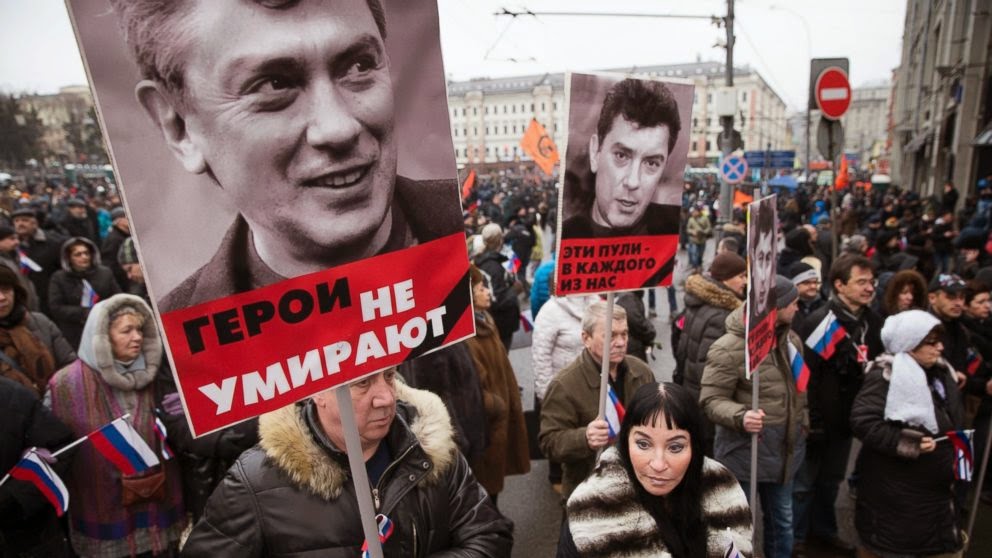
Nemtsov’s March and the Russian Opposition
By Richard Arnold
Nearly 50,000 people participated in a memorial march, on Sunday, March 1, in Moscow, for the slain opposition figure Boris Nemtsov (gunned down in a public street on February 27). The march was originally planned by Russian opposition figures, including Nemtsov, to protest against the war in Ukraine and the economic crisis that has resulted from it. But following the murder of the former deputy prime minister, the organizers turned it into a memorial march. Smaller similar demonstrations were also held in other cities across the Russian Federation. The Moscow march began at Slavic Square near the Chinatown metro station (Vesna.today, March 1). While many pundits and Russia-watchers deplored Nemtsov’s murder as an example of the brutality of Putin’s regime, it is not clear that the assassination will intimidate the opposition. Instead, there remains the possibility that it may breathe new life into a movement many thought absent from the Russian political scene.
The march in Moscow was the largest. Here, protestors carried placards reading “Je suis Boris” (a reference to the solidarity marchers that rallied behind the murdered journalists from the Charlie Hebdo magazine in France), “heroes never die,” “he fought for your future,” “he died for his opinion,” and many similar sentiments (TASS, March 1). Others carried Russian flags, suggesting an attempt to wrestle back the meaning of patriotism from its current Kremlin masters. Until now, the Kremlin has had a monopoly on defining the meaning of Russian patriotism, criticizing opposition to its Ukraine policy as “unpatriotic.” While the marchers at the rally on Sunday clearly have a long way to go in contesting this monopoly in anything like a systematic fashion, it does, once again (see Jamestownfoundation.blogspot.com, February 10), show that there are divisions in Russian society.
The Moscow march drew on the same support that has catapulted Alexei Navalny to the forefront of Russian politics (Richard Arnold, Alexei Navalny and the Russian Opposition, Routledge, 2015). On the one hand, the protest drew extreme right nationalists who came to support the release of prisoners of conscience (most of whom are nationalist ideologues, such as the currently imprisoned former leader of the “Movement Against Illegal Immigration” Alexander Belov), peace between Slavic nations, and a Russia for ethnic Russians (Facebook, March 2). One theory floated by the Russian government immediately after Nemtsov’s murder alleges that the politician was killed by an aggrieved ultra-nationalist dismayed by Nemtsov’s opposition to the war in Ukraine. Indeed, nationalist writer Eduard Limonov opined a minority-view conspiracy theory when he said that Nemtsov’s murder was a “provocation with the distant goal of an ultra-liberal victory in Russia” (Kp.ru, February 28). Of course, Nemtsov was himself a liberal politician, and so many of the marchers undoubtedly were of a liberal persuasion. Thus, the murder itself and the memorial march together serve as a metaphor for the forced marriage of oppositionist forces in Russia.
Moscow was not the only city to see a march, and parallel demonstrations were held in cities throughout Russia, including St. Petersburg, Kaliningrad, Yekaterinburg, Kazan, Perm, Vologda, Voronezh, Samara, Barnaul, Izhevsk, Orenburg, Chelyabinsk, Ulyanovsk, Rostov-on-Don, Kirov and Irkutsk, although they attracted less news coverage than the main march in Moscow. In Russia’s second-largest city of St. Petersburg, the march reportedly attracted between 6,000 and 10,000 participants (Fontanka.ru, March 1). The marches in provincial cities were smaller and organized on the social networking site Vkontakte—for example, the march in Kirov (Vk.com, March 2). Participation at the provincial marches varied. Uin Ulyanovsk it attracted only 20 participants (Ulpressa.ru, March 2), but in Novosibirsk as many as 250 protesters took part (Sibfm.news, March 1). The ability of a single event to generate even this amount of open support in a climate marked by fear from the Kremlin’s propaganda machine is impressive. If Nemtsov’s murder was a plot by forces within the regime to repress the opposition, the result instead has been to highlight the country’s opposition forces. Although it has also shined a spotlight on the anti-Kremlin movement’s many divisions.




